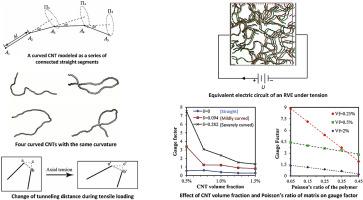European Journal of Mechanics - A/Solids ( IF 4.4 ) Pub Date : 2020-06-09 , DOI: 10.1016/j.euromechsol.2020.104053 X. Chen , A.R. Alian , S.A. Meguid

|
In this first time effort, we developed a coupled electromechanical model of CNT-reinforced composites with realistic morphologies. First, a Monte-Carlo based algorithm was developed to generate representative volume elements (RVEs) reinforced with different concentrations of straight and wavy CNTs. The percolating CNT networks were identified and transformed into an equivalent electric circuit consisting of tunneling and intrinsic resistances. The effective conductivity of the composite was then obtained using the modified nodal analysis method. Second, the structural response of each RVE was obtained using a novel embedded finite element model, where the composite constituents are meshed independently but solved simultaneously by coupling their equilibrium equations. Third, the displacements of the deformed CNTs were updated in the electrical model to calculate the corresponding tunneling distances and the resistance of the deformed system. The gauge factor of the nanocomposite was calculated from the strain-resistance curve. The obtained results indicated that the gauge factor increases with the increase in the curvature of the CNTs. The highest gauge factor of the sensor was attained at concentrations near the percolation threshold. Finally, the gauge factor was found to increase with the decrease in Poisson's ratio of the matrix.
中文翻译:

具有不同形态和浓度的CNT增强纳米复合材料压阻行为的耦合机电模型
在这第一次尝试中,我们开发了具有真实形态的CNT增强复合材料的耦合机电模型。首先,开发了一种基于蒙特卡洛的算法,以生成代表性的体积元素(RVE),并用不同浓度的直链和波浪状CNT增强。渗出的CNT网络被识别并转化为由隧穿和本征电阻组成的等效电路。然后使用改进的节点分析方法获得复合材料的有效电导率。其次,使用新颖的嵌入式有限元模型获得每个RVE的结构响应,其中复合成分独立地划分网格,但通过耦合它们的平衡方程同时求解。第三,在电模型中更新了变形后的碳纳米管的位移,以计算出相应的隧穿距离和变形系统的电阻。从应变-电阻曲线计算出纳米复合材料的规格因子。所得结果表明,规格系数随着CNT的曲率的增加而增加。在接近渗滤阈值的浓度下获得了传感器的最高规格因子。最后,发现规格因子随矩阵泊松比的减小而增加。所得结果表明,规格系数随着CNT的曲率的增加而增加。在接近渗滤阈值的浓度下获得了传感器的最高规格因子。最后,发现规格因子随矩阵泊松比的减小而增加。所得结果表明,规格系数随着CNT的曲率的增加而增加。在接近渗滤阈值的浓度下获得了传感器的最高规格因子。最后,发现规格因子随矩阵泊松比的减小而增加。











































 京公网安备 11010802027423号
京公网安备 11010802027423号